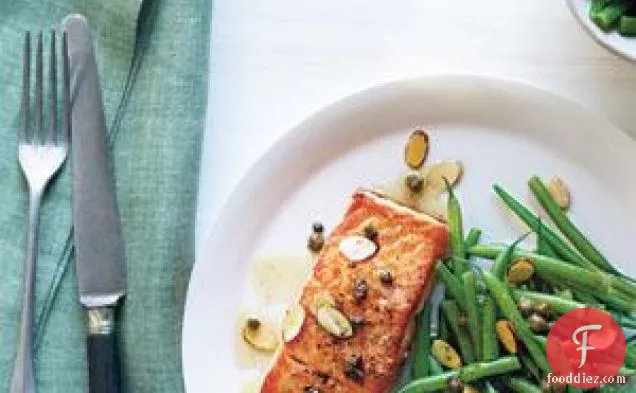Salmon With Brown Butter And Almonds Recipe

Salmon With Brown Butter And Almonds Recipe is a gluten free, primal, fodmap friendly, and pescatarian recipe with 20 servings. One serving contains 78 calories, 6g of protein, and 5g of fat. This recipe covers 6% of your daily requirements of vitamins and minerals. From preparation to the plate, this recipe takes approximately 25 minutes. A mixture of almonds, capers, beans, and a handful of other ingredients are all it takes to make this recipe so flavorful.
Instructions
1
Heat 1 tablespoon of the butter in a large nonstick skillet over medium heat. Season the salmon with teaspoon salt and teaspoon pepper.Cook the fish until opaque throughout, 3 to 5 minutes per side.
Ingredients you will need![Butter]() Butter
Butter![Pepper]() Pepper
Pepper![Salmon]() Salmon
Salmon![Fish]() Fish
Fish![Salt]() Salt
Salt
Equipment you will use![Frying Pan]() Frying Pan
Frying Pan
2
Transfer to individual plates.Meanwhile, fill a second skillet with inch of water, bring to a boil, and add teaspoon salt.
Ingredients you will need![Water]() Water
Water![Salt]() Salt
Salt
Equipment you will use![Frying Pan]() Frying Pan
Frying Pan
3
Add the green beans to the second skillet, cover, and steam until just tender, 4 to 5 minutes.
Ingredients you will need![Green Beans]() Green Beans
Green Beans
Equipment you will use![Frying Pan]() Frying Pan
Frying Pan
Equipment
Ingredients
Recommended wine: Chardonnay, Pinot Noir, Sauvignon Blanc
Salmon on the menu? Try pairing with Chardonnay, Pinot Noir, and Sauvignon Blanc. To decide on white or red, you should consider your seasoning and sauces. Chardonnay is a great friend to buttery, creamy dishes, while sauvignon blanc can complement herb or citrus-centric dishes. A light-bodied, low-tannin red such as the pinot noir goes great with broiled or grilled salmon. You could try Tyler Winery Santa Barbara County Chardonnay. Reviewers quite like it with a 4.1 out of 5 star rating and a price of about 30 dollars per bottle.

Tyler Winery Santa Barbara County Chardonnay
2015 brought the earliest vintage of the decade so far. After the large 2013 and 2014 vintages and the continued drought, the vines put forth a fraction of the fruit than the previous two years. They were down approximately 30% overall but the result was exceptional quality and deep, powerful wines with great acidity. Citrus, anise, saline, and energetic.DifficultyMedium
Ready In25 m.
Servings20
Health Score2
Related recipes
Cherry-Apple Lattice Pie
Garlicky Green Beans
Turkey with Country Ham Stuffing
Striped Tuile Rolls
Magazine

Your Inner Chef with Taylor Swift's Top 3 Recipes from Her Beloved NYC Hangout

20 Mouthwatering Recipes You Need to Try Today!

Master the Art of Making Perfect Pancakes with This Foolproof Recipe

The Science Behind Red Wine: Its Surprising Health Benefits and Potential Risks

12 Wine Cocktails for a Sophisticated Twist

Sip, Swirl, and Celebrate: Toasting to National Wine Day on May 25th

National Drink Wine Day on February 18

Celebrating Souffle Day with Delectable Delights

Indulge in the Delightful Flavor of Oyster Soup on Its Special Day!

Celebrating World Nutella Day

Tips to Ensure the Best BBQ Every Time

A Look at the Relationship Between Nutrition and Sleep

Everything You Need to Know About Traditional German Foods

How to Cook Sushi Rice

How to Make Ice Cream in A bag

How to Make Sushi

How to Make Vegan Pasta

19 Avocado Recipes So You Never Waste One Again

21 Cabbage Recipes to Eat Every Night of the Week

14 Fantastic Cucumber Recipes for Your late Summer

Your Inner Chef with Taylor Swift's Top 3 Recipes from Her Beloved NYC Hangout

Celebrate National Pizza Day on February 9th with Mouthwatering Slices and Fun Facts

10 Foods that Relieve Constipation Naturally

Discover the Nutritional Superpowers of a Brown Food Diet

Indiana's Exciting Addition to the Summer Food Program for School Children

Readers' Top Picks for the Best Restaurant Desserts on National Dessert Day

Artichoke Tomato Pesto Flatbread Recipe A Scrumptious Twist on Savory Classics

Mastering Weeknight Meals with 30 Days of 25-Minute Dinner Recipes

Healthy and Delicious 5-Ingredient Breakfast Recipes







